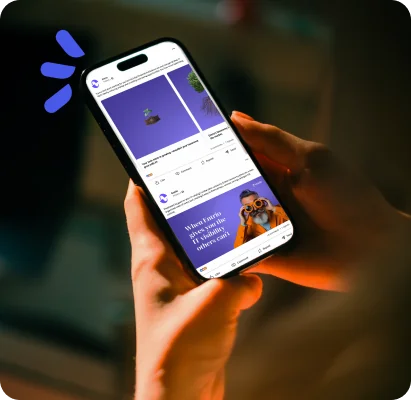
If you’ve worked in B2B long enough, you’ve probably heard the jokes—or lived them. Sales thinks marketing just makes things “look pretty.” Marketing thinks sales ignores all their hard work. The tension’s as old as the funnel itself.
The truth? Both teams want the same thing: growth. But when they don’t speak the same language, they waste energy pointing fingers instead of building momentum.
So, what would happen if marketing and sales switched places for a day? What would they learn about each other’s challenges, strengths, and secret superpowers?
Come with us as we imagine what would happen if these two departments pulled a Freaky Friday swap.
What marketing would learn in sales’ shoes
Marketers think in long-term strategies and campaign timelines. Sales, on the other hand, lives and dies by the quarter—and often by the week. When every conversation can make or break a deal, empathy for the sales team skyrockets fast.
1. Not every MQL is ready to buy.
Only about 13% of MQLs turn into real sales opportunities. We’ve seen SDRs chase every form fill, only to learn the buyer isn’t ready.
The real win? When marketing and sales define what qualified means together. That alignment ensures leads hit sales at the right time—warm, informed, and more likely to convert.
2. Every pitch is live-fire.
In sales, you don’t get to edit your pitch ten times. Prospects decide in seconds whether they trust you.
When marketers see that pressure firsthand, they realize why clarity beats cleverness every time. The right talking points matter more than the prettiest campaign.
3. Objection handling is an art form.
A perfect slide can’t save a weak response. Objection handling takes empathy, timing, and confidence.
Marketing can make it easier by creating sales enablement materials—proof points, success stories, and data—that help reps counter doubts in real time.
4. Details make or break deals.
Sales success isn’t just about product demos—it’s about remembering what matters to buyers: a renewal date, a fiscal year close, even their kid’s soccer game.
Marketing can help make that personalization seamless by sharing behavioral insights—like which case study the prospect read or which webinar they joined—so sales can tailor conversations with ease.
5. Sales feels marketing gaps first.
When a deck doesn’t match the buyer’s questions, it’s sales left flat-footed.
That feedback isn’t criticism—it’s insight. When sales shares what content moves deals forward, marketing can fine-tune strategy and make every piece work harder.
What sales would learn in marketing’s shoes
Now let’s flip it. Sales is fast-moving, immediate, and personal. Marketing is slow-burn, data-driven, and methodical. It’s easy to underestimate just how much science and structure sit behind a great campaign— until you live it.
1. Marketing plans aren’t guesswork.
Every ad starts with weeks of audience research, testing, and segmentation. It’s not “just creative”—it’s the engine behind demand generation.
2. Education takes time.
Buyers today are 69% of the way through their journey before they ever talk to sales. That’s the nurture path in action—hundreds of micro-moments where prospects quietly learn and decide who earns their trust.
Patience pays off. Every touchpoint warms the lead before sales ever steps in.
3. One rogue deck can undo trust.
Brand consistency isn’t cosmetic—it can boost revenue by up to 23%.
When teams go rogue with their own materials, credibility suffers. Consistent visuals and messaging tell a story buyers can believe—and that belief drives conversion.
4. Marketers live in the numbers.
Clicks, conversions, costs, ROI—everything’s tracked.
With 65% of marketing content going unused by sales, marketers constantly analyze what works, what doesn’t, and where to pivot. That agility keeps the pipeline healthy.
5. Resonant messaging takes iteration.
What looks like a simple headline has likely been tested a dozen times. Marketers tweak CTAs and experiment across channels until they find what resonates. That refinement is what brings in the right leads.
What they’d appreciate about each other
If the Freaky Friday swap lasted more than a day, something surprising might happen: mutual appreciation. Once both sides see the strategy and stress behind the other’s work, empathy replaces ego.
When metrics align, revenue grows.
Companies with strong sales and marketing alignment see 208% higher revenue from marketing.
When both teams share KPIs—pipeline health, MQLs, close rates—they stop competing and start compounding growth.
Patience goes both ways.
Sales knows closing a deal can take months. Marketing faces the same reality—testing, revising, optimizing until campaigns perform.
Recognizing each other’s long game reduces friction and builds trust.
Great ideas cross the aisle.
Some of the best content ideas come from sales: real objections, real wins, real stories. Marketing data sharpens every sales pitch. When collaboration flows both ways, the go-to-market motion strengthens.
Shared language drives deals.
When marketing says “engaged lead” and sales says “SQL,” misalignment creeps in. But when both speak in terms of the customer journey, buyers feel it. The experience is seamless, not segmented.
When alignment becomes advantage
At the end of the day, both sales and marketing chase the same goal: growth. But alignment isn’t automatic—it’s built through empathy, curiosity, and shared accountability. When teams understand each other’s goals, challenges, and pressure points, collaboration gets easier and outcomes get stronger.
At Accelity, that’s how we work. Our marketing and client success teams move in sync, aligning strategy, insights, and energy to help our clients grow faster. Learn how we create lead-generating marketing campaigns →
Subscribe to our newsletter
Curated content, news articles, team updates and more.



